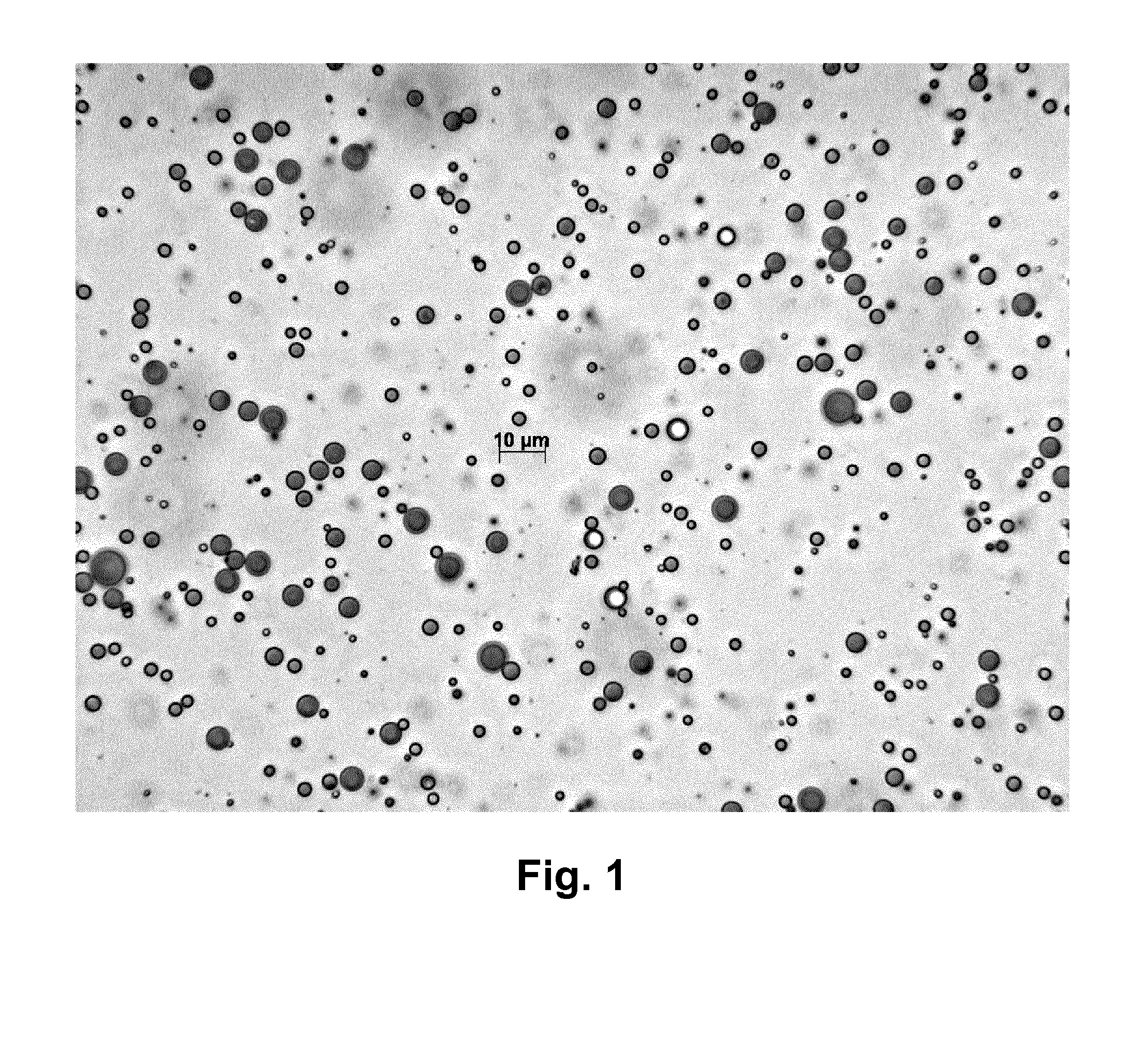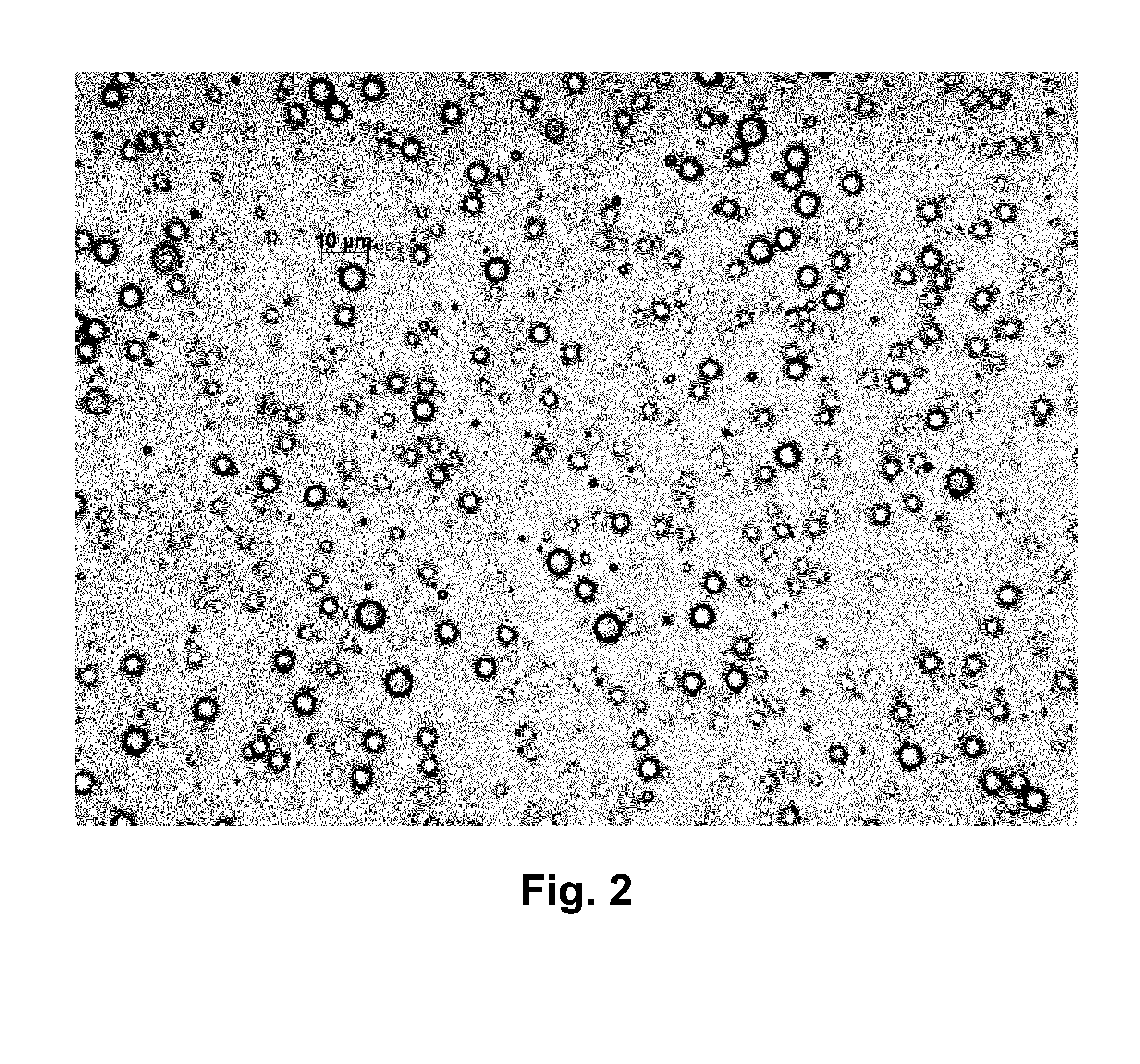Herbicidal composition comprising polymeric microparticles containing a herbicide
a technology of herbicide composition and polymeric microparticles, which is applied in the field of herbicide composition comprising polymeric microparticles containing herbicides to achieve the effect of reducing potential antagonism
- Summary
- Abstract
- Description
- Claims
- Application Information
AI Technical Summary
Benefits of technology
Problems solved by technology
Method used
Image
Examples
example 13
[0359]An optical microscope photograph of the microparticles formed in Polymeric Microparticle Example 13 is shown in FIG. 7 hereinafter, I which the scale-bar shown is 50 micrometres.
[0360]Particle size data were measured by light scattering laser diffraction (either dynamic or static) using a Malvern Mastersizer™ 2000 (available from Malvern Instruments, UK) giving a result for the Polymeric Microparticle Example 13, SJH001 / 009 / 002, as follows:[0361]D(4,3)=volume-weighted mean diameter (mean diameter by volume)=22.5 microns (=micrometres).
Reference Polymeric Microparticle Example 14
Preparation of Dicamba Microparticle Sample #14 (Experiment SJH001 / 035 / 002)
Repeat of Sandoz EP 0 517 669 A1 Example 1
Introduction
[0362]This preparation was intended as a close-to-exact repeat of the preparation of dicamba microparticles disclosed in Example 1 (page 5) of the patent application published as EP 0 517 669 A1 in the name of Sandoz Ltd. As trivial modifications of Example 1 of EP 0 517 669 A...
composition example 4
Preparation of Dicamba Acid as a SC100 (Suspension Concentrate) Composition, for Use in Glasshouse Studies of Biological Examples 1 and 2
[0429]This preparation of dicamba acid suspension concentrate (100 g / L AE) was achieved by dispersing dicamba acid (87.9% purity technical material) into de-ionised water using Morwet® D425 as the stabilizing agent. Specifically, 0.114 grams of dicamba acid technical was added to 0.0136 grams of Morwet® D425 and 0.9085 grams of de-ionised water followed by bead milling using standard techniques at a small laboratory scale. The material as 100SC was well-behaved during preparation and subsequent storage at ambient temperature. It is further noted that upon dilution for spraying in the glasshouse experiment, the dicamba acid particles (from the 100SC) dissolve fully, which is commensurate with the water solubility of dicamba acid.
[0430]Morwet® D425 (available from Akzo Nobel; www.akzonobel.com) is a naphthalene-based dispersant suitable for preparing...
example 5
Reference Composition Example 5
MCPA Potassium SL050 Composition
[0431]MCPA acid (10.5 g, 0.05 mole) was added to 30 ml water with 1.2 molar equivalents of KOH (85%) and stirred until all solid had dissolved, before diluting with water to the desired concentration.
PUM
 Login to View More
Login to View More Abstract
Description
Claims
Application Information
 Login to View More
Login to View More - R&D
- Intellectual Property
- Life Sciences
- Materials
- Tech Scout
- Unparalleled Data Quality
- Higher Quality Content
- 60% Fewer Hallucinations
Browse by: Latest US Patents, China's latest patents, Technical Efficacy Thesaurus, Application Domain, Technology Topic, Popular Technical Reports.
© 2025 PatSnap. All rights reserved.Legal|Privacy policy|Modern Slavery Act Transparency Statement|Sitemap|About US| Contact US: help@patsnap.com



